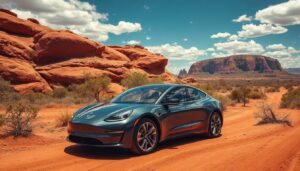Introduction
Electric vehicles are gaining popularity across Australia and around the world. With better technology and more choices, more people are considering EVs for their daily drives. But what about the cost? Understanding how much electric cars cost in Australia is key for buyers and investors alike. Many factors, like government incentives, available models, and charging stations, influence prices. This guide looks into all those factors to help you pick the right electric car without surprises.
Understanding the Factors That Influence Electric Car Prices in Australia
Market Dynamics and Demand
The cost of EVs depends a lot on what buyers want and what’s available. As more Australians choose electric cars, prices tend to go down. Recently, EV adoption has been growing quickly, making competition fiercer. When demand rises, prices for popular models can stay high, but newer options might become more affordable.
Government Incentives and Subsidies
The Australian government offers different perks to make EVs cheaper. Federal and state programs sometimes give rebates or lower taxes on electric cars. For example, some states give thousands of dollars off the price for early buyers. These incentives can cut hundreds or even thousands from the final cost, making EVs more accessible.
Manufacturing and Import Costs
Most electric cars in Australia are imported. Trade tariffs, shipping, and taxes affect their prices. Cars made locally can be cheaper because they avoid some import fees. Still, local assembly isn’t common yet, which keeps many EVs at higher prices. These costs ripple through retailer prices, affecting what you pay.
Charging Infrastructure and Total Ownership Cost
Owning an EV isn’t just about the sticker price. You also need to think about charging. Installing a home charger costs money but can save heaps over time. Public charging stations are popping up everywhere, but charging fees vary. All these costs influence how you see the true value of an EV, especially in overall ownership costs.
Current Electric Car Models Available in Australia and Their Prices
Popular Electric Sedans and Hatchbacks
- Tesla Model 3: Prices usually start around AUD $60,000. It’s known for long range and tech features.
- Nissan Leaf: This budget-friendly EV sells for around AUD $45,000. It’s compact and easy to drive.
- MG ZS EV: An affordable option at about AUD $40,000 with decent range and good features.
Electric SUVs and Crossovers
- Hyundai Kona Electric: Ranges from AUD $55,000 to $65,000. It offers good space and performance.
- Kia EV6: Starts at approximately AUD $70,000. It’s a more premium option with advanced tech.
- Audi e-tron: Luxury SUV pricing begins around AUD $120,000. It combines style with comfort.
Luxury and High-End EVs
- Tesla Model S: This high-end car costs from AUD $130,000 upwards. It’s famous for speed and tech.
- Porsche Taycan: For luxury buyers, prices start near AUD $160,000. It packs performance and prestige.
Emerging and Upcoming Models
New electric vehicles are entering the Australian market often. Rivian R1T and similar trucks are expected soon. Prices could be upwards of AUD $80,000, but they might revolutionize the market with new features.
Breakdown of Total Cost of Ownership in Australia
Purchase Price vs. Long-Term Savings
Initial costs are just part of the story. EVs save money by reducing fuel and maintenance bills. Over five years, some drivers save thousands compared to petrol cars. Think of it like buying a cheaper phone that saves on bills over time.
Maintenance and Service Costs
Electric cars have fewer moving parts, so repairs are fewer and cheaper. For example, brake parts last longer thanks to regenerative braking. Many popular EVs cost less to keep running.
Charging Expenses
Charging at home is often cheapest. Using public stations costs more but offers convenience. Electricity prices vary across Australia, affecting your monthly cost. If you charge mainly at home, expect to spend around AUD $10–$20 a week on electricity.
Resale Value and Depreciation
Like all vehicles, EV value drops over time. But higher demand means better resale prices are possible. Maintaining your EV well and choosing popular models can help keep its value high.
The Future of Electric Car Pricing in Australia
Impact of Evolving Technology
Batteries are getting cheaper fast. As production scales up, prices could drop by 50% within the next decade. Better manufacturing processes also lead to more affordable EV models.
Policy Changes and Incentives
Government policies may change. If more incentives are introduced, prices will fall further. Conversely, if perks are reduced, buyers might need to pay more upfront. It’s important to stay updated on policy shifts.
Market Saturation and Competition
More manufacturers entering Australia means more choices and competitive prices. As more affordable EVs hit the market, prices will likely decline, making EVs available to a broader audience.
Consumer Trends and Adoption
More Australians want EVs, which can drive prices up temporarily. However, leasing and finance plans are making EVs more affordable for many. These options can lower upfront costs and shift the focus to manageable monthly payments.
Conclusion
Electric vehicle prices in Australia depend on multiple factors, including market demand, government incentives, and manufacturing costs. While prices vary widely, it’s essential to think about the total cost of ownership—fuel, maintenance, and charging—when making a decision. With technology improving and policies shifting, EVs will likely become more affordable in the future. To find the best value, compare models, stay informed about incentives, and consider long-term savings. This way, owning an electric car becomes not just a choice for the environment but a smart investment for your wallet.




